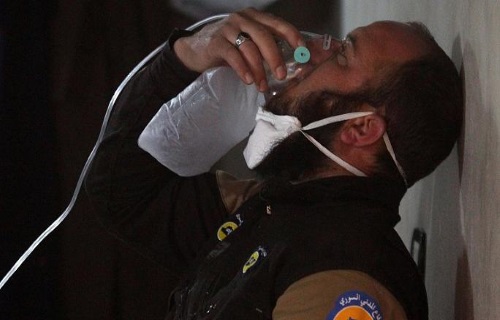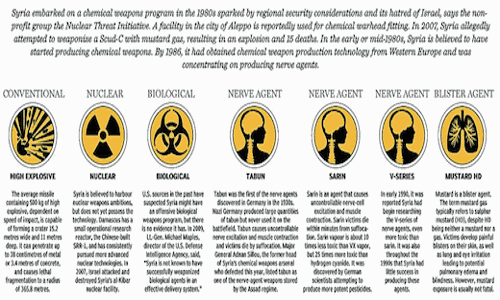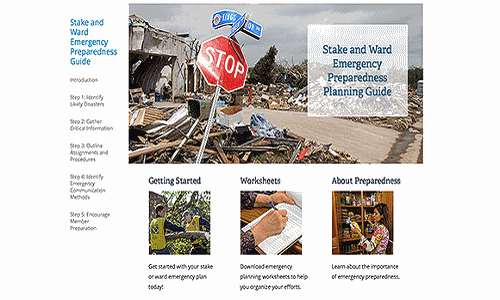What to Do in a Gas Attack
Chemical warfare (CW) involves using the toxic properties of chemical substances as weapons. This type of warfare is distinct from nuclear warfare and biological warfare, which together make up NBC, the military acronym for nuclear, biological, and chemical (warfare or weapons), all of which are considered “weapons of mass destruction” (WMDs). None of these fall under the term conventional weapons which are primarily effective due to their destructive potential. With proper protective equipment, training, and decontamination measures, the primary effects of chemical weapons can be overcome. Many nations possess vast stockpiles of weaponized agents in preparation for wartime use. The threat and the perceived threat have become strategic tools in planning both measures and counter-measures.
Possible Signs of Chemical Threat
Many people suffering from watery eyes, twitching, choking, having trouble breathing or losing coordination. Many sick or dead birds, fish or small animals are also cause for suspicion.
- Quickly try to define the impacted area or where the chemical is coming from, if possible.
- Take immediate action to get away.
- If the chemical is inside a building where you are, get out of the building without passing through the contaminated area, if possible.
- Otherwise, it may be better to move as far away from where you suspect the chemical release is and “shelter-in-place.”
- If you are outside, quickly decide what is the fastest escape from the chemical threat. Consider if you can get out of the area, or if you should follow plans to “shelter-in-place.”
- If You Think You Have Been Exposed to a Chemical
- If your eyes are watering, your skin is stinging, and you are having trouble breathing, you may have been exposed to a chemical.
- If you think you may have been exposed to a chemical, strip immediately and wash.
- Look for a hose, fountain, or any source of water, and wash with soap if possible, being sure not to scrub the chemical into your skin.
Responding To An Attack
Aside from their common lethality, there is no one size fits all when it comes to describing the types and effects of possible chemical or biological agents. Chemical agents are generally liquids, often aerosolized, and most have immediate effects or are delayed for a few hours. Many chemical agents have a unique odor and color.
Biological agents differ in that the effects are delayed, often for days. The effects of toxins, such as botulism toxin, occur typically in less than a day. Living biological agents, such as anthrax or plague, generally take 2-5 days for symptoms to appear. Biological agents have no odor or color and can be in either liquid or powder form.
There are many different potential chemical and biological agents that a terrorist could use as a weapon, but we can make the following broad generalizations:
Although food or water contamination or absorption through the skin are possible attack routes, most experts agree that inhalation of chemical or biological agents is the most likely and effective means. Protection of breathing airways is therefore the single most important factor in a situation where chemical or biological agents may be present.
Many likely agents are heavier than air and would tend to stay close to the ground. This dictates an upward safe-haven strategy.
- Basic decontamination procedures are generally the same no matter what the agent.
- Thorough scrubbing with large amounts of warm soapy water or a mixture of 10 parts water to 1 part bleach (10:1) will greatly reduce the possibility of absorbing an agent through the skin.
- If water is not available, talcum powder or flour are also excellent means of decontamination of liquid agents. Sprinkle the flour or powder liberally over the affected skin area, wait 30 seconds, and brush off with a rag or gauze pad. (Note: the powder absorbs the agent so it must be brushed off thoroughly. If available, rubber gloves should be sued when carrying out this procedure.)
- Generally, chemical agents tend to present an immediately noticeable effect, whereas many biological agents will take days before symptoms appear. In either case, medical attention should be sought immediately, even if exposure is thought to be limited.
- Most chemical and biological agents that present an inhalation hazard will break down fairly rapidly when exposed to the sun, diluted with water, or dissipated in high winds.
- No matter what the agent is or its concentration, evacuation from the area of attack is always advisable unless you are properly equipped with an appropriate breathing device and protective clothing or have access to collective protection.
Warning Signs of a Chemical Attack or Incident
- A chemical or biological attack or incident won’t always be immediately apparent given the fact that many agents are odorless and colorless and some cause no immediately noticeable effects or symptoms. Be alert to the possible presence of agents. Indicators of such an attack include:
- Droplets of oily film on surfaces
- Unusual dead or dying animals in the area
- Unusual liquid sprays or vapors
- Unexplained odors (smell of bitter almonds, peach kernels, newly mown hay or green grass)
- Unusual or unauthorized spraying in the area
- Victims displaying symptoms of nausea, difficulty breathing, convulsions, disorientation, or patterns of illness inconsistent with natural disease
- Low-lying clouds or fog unrelated to weather; clouds of dust; or suspended, possibly colored, particles
- People dressed unusually (long-sleeved shirts or overcoats in the summertime) or wearing breathing protection particularly in areas where large numbers of people tend to congregate, such as subways or stadiums
Best Post Collapse First Aid Survival Guide Ever
What to Do In Case of Attack
Protection of breathing airways is the single most important thing a person can do in the event of a chemical or biological incident or attack. In most cases, absent a handy gas mask, the only sure way to protect an airway is to put distance between you and the source of the agent. While evacuating the area, cover your mouth and nose with a handkerchief, coat sleeve or any piece of cloth to provide some moderate means of protection. Other basic steps one can take to avoid or mitigate exposure to chemical or biological agents include:
- Stay alert for attack warning signs. Early detection enhances survival.
- Move upwind from the source of the attack.
- If evacuation from the immediate area is impossible, move indoors (if outside) and upward to an interior room on a higher floor. Remember many agents are heavier than air and will tend to stay close to the ground.
- Once indoors, close all windows and exterior doors and shut down air conditioning or heating systems to prevent circulation of air.
- Cover your mouth and nose. If gas masks are not available, use a surgical mask or a handkerchief. An improvised mask can be made by soaking a clean cloth in a solution of 1 tablespoon of baking soda in a cup of water. While this is not highly effective, it may provide some protection.
- Cover bare arms and legs and make sure any cuts or abrasions are covered or bandaged.
- If splashed with an agent, immediately wash it off using copious amounts of warm soapy water or a diluted 10:1 bleach solution.
- Letters from unknown sources should first be screened by security personnel. If opened, letters allegedly containing anthrax or another toxin should be handled carefully. Note if there was a puff of dust or particles from the envelope when it was opened and be sure to report that when assistance arrives. Carefully place such a letter and its envelope in a sealed plastic pouch. Thoroughly wash face and hands with warm soapy water before calling for assistance.
- If circumstances dictate, plan and prepare a chemical/biological safe-haven in your residence
- At the office, familiarize yourself in advance with established emergency procedures and equipment at your post. See your regional or post security officer for details.
- If in a car, shut off outside air intake vents and roll up windows if no gas has entered the vehicle. Late model cars may provide some protection from toxic agents.
- In any case of suspected exposure to chemical or biological agents, no matter what the origin, medical assistance should be sought as soon as possible, even if no symptoms are immediately evident.
Preparing a Saferoom
In some remote but possible scenarios, an entire city or neighborhood could become endangered by lethal gas. If conditions at your post make this a possibility, you may want to plan and prepare a sealed chemical/biological safe-haven at your residence as follows:
Choosing a Saferoom
- Select an inner room on an upstairs floor with the least number of windows and doors.
- Choose a large room with access to a bathroom and preferably with a telephone.
- Avoid choosing rooms with window or wall air conditioners; they are more difficult to seal.
- Shut down all window and central air and heating units.
Emergency Preparedness – Planning Ahead
Preparing for an emergency now, provides you your best chance of survival, in the event of an actual attack. Emergency preparedness should always be considered in the home and workplace for any unexpected event.
This site provides a step-by-step approach to emergency preparedness by walking the reader through emergency plans in a variety of scenarios. As you make your emergency plan, carefully consider the information you’ll find throughout this website.
Introduction To Emergency Preparedness
Devastating acts, such as 911 and the terrorist attacks on the World Trade Center and the Pentagon, have left many concerned about the possibility of future events and their potential impact. They have raised uncertainty and heightened our awareness of the importance of emergency preparedness. There are specific steps you can take to prepare for the unexpected and reduce the stress that you may feel now and later should another emergency arise. Taking preparatory action can reassure you, your family and co-workers n that you can exert a measure of control even in the face of such events.
Emergency Preparedness – What You Can Do to
Finding out what can happen is the first step. Once you have determined the events possible and their potential in your community, it is important that you discuss them with your family or household. Develop a disaster/ emergency preparedness plan together.
Create an emergency communications plan.
Choose an out-of-town contact your family or household will call or e-mail to check on each other should a disaster occur. Your selected contact should live far enough away that they would be unlikely to be directly affected by the same event, and they should know they are the chosen contact.
Make sure every household member has that contact’s, and each other’s, e-mail addresses and telephone numbers (home, work, pager and cell). Leave these contact numbers at your children’s schools, if you have children, and at your workplace. Your family should know that if telephones are not working, they need to be patient and try again later or try e-mail. Many people flood the telephone lines when emergencies happen but e-mail can sometimes get through when calls don’t.
Establish meeting places.
Having predetermined meeting places away from your home will save time and minimize confusion should your home be affected or the area evacuated. You may even want to make arrangements to stay with a family member or friend in case of an emergency. Be sure to include any pets in these plans, since pets are not permitted in shelters and some hotels will not accept them. Have two emergency locations, each in opposite directions. You won’t know, until an actual emergency, which direction you will need to evacuate.
Assemble a disaster supplies or 72 hour emergency preparedness kit.
If you need to evacuate your home or are asked to “shelter in place,” having some essential supplies on hand will make you and your family more comfortable. Prepare an emergency preparedness kit in an easy-to-carry container such as a duffel bag or small plastic trash can. Include “special needs” items for any member of your household (infant formula or items for people with disabilities or older people), first aid supplies (including prescription medications), a change of clothing for each household member, a sleeping bag or bedroll for each, a battery powered radio or television and extra batteries, food, bottled water and tools.
It is also a good idea to include some cash and copies of important family documents (birth certificates, passports and licenses) in your kit. Copies of essential documents-like powers of attorney, birth and marriage certificates, insurance policies, life insurance beneficiary designations and a copy of your will-should also be kept in a safe location outside your home. A safe deposit box or the home of a friend or family member who lives out of town is a good choice.
Check on the school emergency preparedness plan of any school-age children you may have.
You need to know if they will they keep children at school until a parent or designated adult can pick them up or send them home on their own. Be sure that the school has updated information about how to reach parents and responsible caregivers to arrange for pickup. And, ask what type of authorization the school may require to release a child to someone you designate, if you are not able to pick up your child. During times of emergency the school telephones may be overwhelmed with calls.
- Remain calm and be patient.
- Follow the advice of local emergency officials.
- Listen to your radio or television for news and instructions.
- If the disaster occurs near you, check for injuries. Give first aid and get help for seriously injured people.
If the disaster occurs near your home while you are there, check for damage using a flashlight. Do not light matches or candles or turn on electrical switches. Check for fires, fire hazards and other household hazards. Sniff for gas leaks, starting at the water heater. If you smell gas or suspect a leak, turn off the main gas valve, open windows, and get everyone outside quickly.
- Shut off any damaged utilities.
- Confine or secure your pets.
- Call your family contact, do not use the telephone again unless it is a life-threatening emergency.
- Check on your neighbors, especially those who are elderly or disabled.
What Could Happen – Emergency Planning
As we learned from the events of September 11, 2001, the following things can happen after a terrorist attack:
- There can be significant numbers of casualties and/or damage to buildings and the infrastructure. So employers need up-to-date information about any medical needs you may have and on how to contact your designated beneficiaries.
- Heavy law enforcement involvement at local, state and federal levels follows a terrorist attack due to the event’s criminal nature.
- Health and mental health resources in the affected communities can be strained to their limits, maybe even overwhelmed.
- Extensive media coverage, strong public fear and international implications and consequences can continue for a prolonged period.
- Workplaces and schools may be closed, and there may be restrictions on domestic and international travel.
- You and your family or household may have to evacuate an area, avoiding roads blocked for your safety.
Evacuation in an emergency
If local authorities ask you to leave your home, they have a good reason to make this request, and you should heed the advice immediately. Listen to your radio or television and follow the instructions of local emergency officials and keep these simple tips in mind.
- Wear long-sleeved shirts, long pants and sturdy shoes so you can be protected as much as possible.
- Take your disaster supplies kit.
- Take your pets with you; do not leave them behind. Because pets are not permitted in public shelters, follow your plan to go to a relative’s or friend’s home, or find a “pet-friendly” hotel.
- Lock your home.
- Use travel routes specified by local authorities, don’t use shortcuts because certain areas may be impassable or dangerous. Have planned routes out of any possible danger areas. Plane for leaving in any direction, North, South, East or West.
- Stay away from downed power lines.
- Listen to local authorities.Your local authorities will provide you with the most accurate information specific to an event in your area. Staying tuned to local radio and television, and following their instructions is your safest choice.
If you’re sure you have time …additional emergency prepareness actions
- Call your family contact to tell them where you are going and when you expect to arrive.
- Shut off water and electricity before leaving, if instructed to do so. Leave natural gas service ON unless local officials advise you otherwise. You may need gas for heating and cooking, and only a professional can restore gas service in your home once it’s been turned off. In a disaster situation it could take weeks for a professional to respond.
- Close and lock all windows and exterior doors. Turn off all fans, heating and air conditioning systems. Close the fireplace damper. Get your disaster supplies kit, and make sure the radio is working.
- Go to an interior room without windows that’s above ground level.
- In the case of a chemical threat, an above-ground location is preferable because some chemicals are heavier than air, and may seep into basements even if the windows are closed.
- Using duct tape, seal all cracks around the door and any vents into the room.
- Keep listening to your radio or television until you are told all is safe or you are told to evacuate. Local officials may call for evacuation in specific areas at greatest risk in your community.
Additional Steps You Can Take
Raw, unedited footage of terrorism events and people’s reaction to those events can be very upsetting, especially to children. We do not recommend that children watch television news reports about such events, especially if the news reports show images over and over again about the same incident. Young children do not realize that it is repeated video footage, and think the event is happening again and again.
Adults may also need to give themselves a break from watching disturbing footage. However, listening to local radio and television reports will provide you with the most accurate information from responsible governmental authorities on what’s happening and what actions you will need to take. So you may want to make some arrangements to take turns listening to the news with other adult members of your household.
Another useful preparation includes learning some basic first aid. To enroll in a first aid and AED/CPR course, contact your local American Red Cross chapter.
In an emergency situation, you need to tend to your own well-being first and then consider first aid for others immediately around you, including possibly assisting injured people to evacuate a building if necessary.
People who may have come into contact with a biological or chemical agent may need to go through a decontamination procedure and receive medical attention. Listen to the advice of local officials on the radio or television to determine what steps you will need to take to protect yourself and your family. As emergency services will likely be overwhelmed, only call 9-1-1 about life-threatening emergencies.
Emergency preparedness – Each Persons Responisbility
Don’t wait until disaster strikes to realize the benefits of a good emergency preparedness plan. Begin gathering the items you will need and going over your plan with all family members, at regular intervals.
There is still time for you to prepare, but you have to start learning how to make your own survival foods as soon as humanly possible. The best way to do it is to get the inside scoop on how to do it right. Fortunately, there is a way to get twenty years worth of The Lost Ways. This new food storage system is called The Lost Ways. You do not need a lot of expensive equipment to store foods for a crisis using the methods taught here. Even better, The Lost Ways pays for itself quickly as you begin to put away garden produce or even meats that you buy on sale. For most folks it’s simply the biggest bargain of their lives. You can finally become self-sufficient and any extra money saved in food expense goes right back to your pocket. Frankly, at the end of the day, The Lost Ways actually makes you money! What’s more, the videos take you by the hand, step by step, through the entire process of “putting away” almost any food you can think of. It’s very much like having a food storage professional right there with you every step of the way.
Books can be your best pre-collapse investment.
The Lost Ways (Learn the long forgotten secrets that helped our forefathers survive famines,wars,economic crisis and anything else life threw at them)
Survival MD (Best Post Collapse First Aid Survival Guide Ever)
Conquering the coming collapse (Financial advice and preparedness )
Liberty Generator (Build and make your own energy source)
Backyard Liberty (Easy and cheap DIY Aquaponic system to grow your organic and living food bank)
Bullet Proof Home (A Prepper’s Guide in Safeguarding a Home )
Family Self Defense (Best Self Defense Strategies For You And Your Family)
Survive Any Crisis (Best Items To Hoard For A Long Term Crisis)
Survive The End Days (Biggest Cover Up Of Our President)
Drought USA (Discover The Amazing Device That Turns Air Into Water)
SOURCE : nationalterroralert.com






Wharto do in a chemical attack ??? RUN .